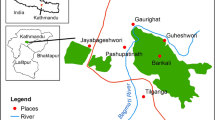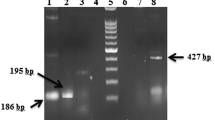Abstract
Entamoeba histolytica is a eukaryotic protozoan parasite responsible for amoebiasis. Its genetic diversity throughout the world as well as its impact on the outcome of infection is still a mystery. In the present study, a total of 774 stool samples were tested by microscopy, TechLab enzyme-linked immunosorbent assays (ELISAs) and multiplex PCR for the presence of Entamoeba histolytica. For genotype analysis, six different loci (NK, RR, AL, DA and STGA-D) of the tRNA genes were amplified by PCR. The genotyping as well as the demographic data were analyzed using the Statistical Package for Social Sciences (SPSS for WINDOWS version 21.0) program. The overall prevalence of Entamoeba species varied from 5.4% to 10.5 % and was higher in urban area. The genetic profiling of E. histolytica indicated that some strains were specific to each of the two locations while some were common. Profile Number 1 of the NK locus was more prevalent in diarrhea samples and was from Pretoria. Similarly, some profiles were more associated with diarrhea compared to others further indicating that the outcome of the infection by this parasite might be associated with the genotype. The results also indicated the possibility of strains clustering by region. The results obtained in this study confirm that tRNA genes might have a role in the presentation of amoebiasis (symptomatic and asymptomatic infections) depending on the genetic profile of the infecting strain. This genotyping system could also be used to identify the origin of the infection once it has been standardized.
Access this chapter
Tax calculation will be finalised at checkout
Purchases are for personal use only
Similar content being viewed by others
Abbreviations
- tRNA:
-
transfer Ribonucleic Acid
- ELISA:
-
Enzyme Linked Immuno-Sorbent Assay
- PCR:
-
Polymerase Chain Reaction
- NK, RR, AL, DA and STGA-D:
-
Symbols representing the different tRNA genes
- SPSS:
-
Statistical Package for Social Science
- STR:
-
Short Tandem Repeat
- DNA:
-
Deoxy-ribonucleic acid
- OD:
-
Optical density
- MEDUNSA:
-
Medical University of South Africa
References
Al-Harthi, S. A., & Jamjoom, M. B. (2007). Enteroparasitic occurrence in stools from residents in Southwestern region of Saudi Arabia before and during Umrah season. Saudi Medical Journal, 28, 386–390.
Ali, I. K. M., Clark, C. G., & Petri, W. A., Jr. (2008). Molecular epidemiology of amoebiasis. Infection, Genetics and Evolution, 8, 698–707.
Ali, I. K. M., Mondal, U., Roy, S., Haque, R., Petri Jr., W. A., Clark, C.G. (2007) Evidence fora link between parasite genotype and outcome of infection with Entamoeba histolytica.Journal of Clinical Microbiology, 45, 285–289.
Ali, E., Samie, A., Sandi, E., & Raed, A. O. (2014). Genetic variability of the Serine-Rich Entamoeba histolytica protein gene in clinical isolates from the United Arab Emirates. Tropical Biomedicine, 31(2), 370–377.
Ali, I. K. M., Zaki, M., & Clark, C. G. (2005). Use of PCR amplification of tRNA gene-linked short tandem repeats for genotyping Entamoeba histolytica. Journal of Clinical Microbiology, 43, 5842–5847.
Al-Shammari, S., Khoja, T., El-Khwasky, F., & Gad, A. (2001). Intestinal parasitic diseases in Riyadh Saudi Arabia: Prevalence, sociodemographic and environmental associates. Tropical Medicine & International Health, 6(3), 184–189.
Alum, A., Rubino, J. R., & Ijaz, M. K. (2010). The global war against intestinal parasites-should we use holistic approach? The International Journal of Infectious Diseases (IJID), 14, e732–e738.
Bern, M. C., & Guerrant, R. L. (2003). The global burden of diarrheal disease, as estimated from studies published between 1992 and 2000. Bulletin of the World Health Organization (WHO), 81, 197–204.
Das, K., Mukherjee, A. K., Chowdhury, P., Sehgal, R., & Bhattacharya, M. K. (2014). Multilocus sequence typing system (MLST) reveals a significant association of Entamoeba histolytica genetic patterns with disease outcome. International Journal for Parasitology, 66, 308–314.
Dawood, K. A., Al-Muhja, R., Al-Zubaidy, F., & Al-Abbas, J. A. (2002). A study of giardia and amoebiasis in maternity and Hospital of Diwania, Kufa. Journal of Medicine, 5(1), 167–170.
Ejaz, M., Murtaza, G., Ahmad, M., Khan, S. A., Saqib, Q. N., Asad, M. H. H. B., et al. (2011). Determination of the prevalence of Entamoeba histolytica in human ata private fertilizer company hospital in Pakistan using microscopic technique. African Journal of Microbiology Research, 5, 149–152.
Feng, M., Cai, J., Yang, B., Fu, Y., Min, X., Tahibana, H., et al. (2012). Unique short tandem repeat nucleotide sequences in Entamoeba histolytica isolates from China. Parasitology Research, 111, 1137–1142.
Haghighi, A., Kobayashi, S., Takeuchi, T., Masuda, G., & Nozaki, T. (2002). Remarkable genetic polymorphism among Entamoeba histolytica isolates from a limited geographic area. Journal of Clinical Microbiology, 40, 4081–4090.
Hamzah, Z., Petmitr, S., Mungthin, M., Leelayoova, S., & Chavalitshewinkoon-Petmitr, P. (2006). Differential detection of Entamoeba histolytica, Entamoeba dispar, and Entamoeba moshkovskii by a single-round PCR assay. Journal of Clinical Microbiology, 44, 3196–3200.
Jaiswal, V., Ghoshal, U., Mittal, B., Dhole, T. N., & Ghoshal, U. C. (2014). Association between allelic variation due to short tandem repeats in tRNA gene of Entamoba histolytica and clinical phenotypes of amoebiasis. Acta Tropica, 133, 1–7.
Ozgumus, O. B., Celik-Sevim, E., Alpay-Karaoglu, S., Sandallic, C., & Sevim, A. (2007). Molecular characterization of antibiotic resistant Escherichia coli strains isolated from tap and spring waters in a Coastal Region in Turkey. International Journal of Microbiology, 45, 379–387.
Ozyurt, M., Kurt, O., Yaman, O., Ardic, N., & Haznedaroglu, T. (2007). Evaluation of intestinal parasites in a period of four years in the coprology laboratory of a training hospital. Turkish Parazirol Derg, 31, 306–308.
Parija, S. C., & Prabhakar, P. K. (1995). Evaluation of lacto-phenol cotton blue for wet mount preparation of feces. Journal of Clinical Microbiology, 33, 1019–1021.
Pham Duc, P., Nguyen-Viet, H., Hattendorf, J., Zinsstag, J., Dac Cam, P., & Odermatt, P. (2011). Risk factors for Entamoeba histolytica infection in an agricultural community in Hanam Province Vietnam. Parasit Vectors, 4, 102.
Samie, A., Obi, C. L., Bessong, P. O., Houpt, E., Stroup, S., Njayou, M., et al. (2008). Entamoeba histolytica: genetic diversity of African strains based on the polymorphism of the serine-rich protein gene. Experimental Parasitology, 118, 354–361.
Stanley, S. L. (2003). Amoebiasis. Lancet, 361, 1025–1034.
Stark, D., van Hal, S., Fotedar, R., Butcher, A., Marriott, D., Ellis, J., et al. (2008). Comparison of stool antigen detection kits to PCR for diagnosis of amebiasis. Journal of Clinical Microbiology, 46, 1678–1681.
Tanyuksel, M., & Petri, W. A., Jr. (2003). Laboratory diagnosis of amoebiasis. Clinical Microbiology Reviews, 16, 713–729.
Tawari, B., Ali, I. K. M., Scott, C., Quail, M. A., Berriman, M., & Hall, N. (2008). Patterns of evolution in the unique tRNA gene arrays of the genus Entamoeba. Molecular Biology and Evolution, 25, 187–198.
Ximenez, C., Cerritos, R., & Roja, L. (2010). Human amoebiasis: Breaking the paradigm? International Journal of Environmental Research and Public Health (IJERPH), 7(3), 1105–1120.
Acknowldgements
The authors express their sincere gratitude to the rural primary health care clinics management in Giyani, Limpopo Province and private clinics management in Pretoria, Gauteng Province as well as the patients for their cooperation. This study received financial support from a grant made available to Prof. A Samie through the National Research Foundation.
Competing Interest
The authors declare that they have no competing interests.
Author information
Authors and Affiliations
Corresponding author
Editor information
Editors and Affiliations
Rights and permissions
Copyright information
© 2020 Springer Nature Switzerland AG
About this paper
Cite this paper
Davhana, N.C., Mbati, P.A., Samie, A. (2020). Molecular Characterization of Entamoeba histolytica tRNA Genes. In: Guillen, N. (eds) Eukaryome Impact on Human Intestine Homeostasis and Mucosal Immunology. Springer, Cham. https://doi.org/10.1007/978-3-030-44826-4_21
Download citation
DOI: https://doi.org/10.1007/978-3-030-44826-4_21
Published:
Publisher Name: Springer, Cham
Print ISBN: 978-3-030-44825-7
Online ISBN: 978-3-030-44826-4
eBook Packages: Biomedical and Life SciencesBiomedical and Life Sciences (R0)




